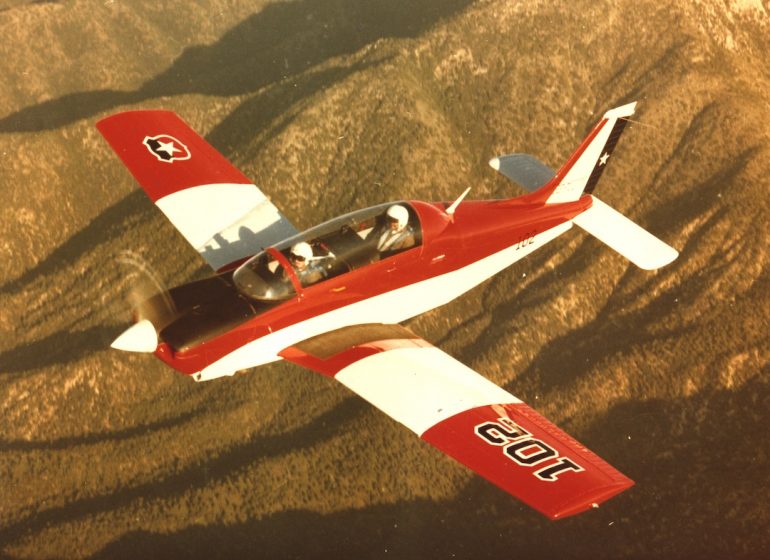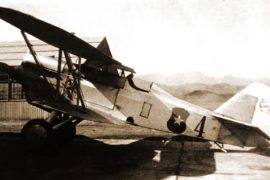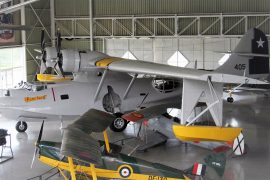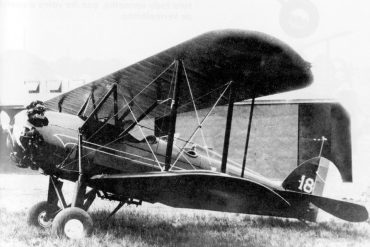While it is true that the development of the T-35 Pillán has been extensively covered since the first prototype took to the air in March 1981, it is not less true that the first steps for this training aircraft -for which different configurations were tested- cause confusion when it comes to the specific identification of each of the prototypes and pre-production aircraft. Therefore, we will provide the readers with data that will enable them to know the history of these prototypes; the data comes from the Chilean National Aircraft Registry, the National Aeronautical and Space Museum’s archives of aircraft removed from the registry, and also through photographs, many of them never published before.
The prototypes
The first Pillán prototype, model PA-28R-300, was designed and built by the Piper Aircraft Company’s Advanced Engineering and Experimental Department, in Lakeland, Florida. It took to the air for the first time on March 6, 1981, with the factory test pilot, Hugh Smith, at the controls. A series of tests were conducted on this prototype, amongst which there were controls, speed, spins, flutter, prolonged inverted flight, engine lubrication, fuel, brake hydraulics and so on.

Not much time passed after the point when the Fuerza Aérea de Chile -FACh- (Chilean Air Force) gave its approval for the work being done, and ordered the production of a second prototype and three pre-production examples, for N300BT (c/n 28R-300-01) to be taken to Chile in January 1982. It retained the U.S. registration for the flights in country and also wore the XBT sign (for eXperimental Basic Trainer). Its operational life in country regrettably, was short since it had an accident at the El Bosque airbase, in Santiago, on February 26, 1982, shortly before the Feria Internacional del Aire -FIDA- (International Air Fair) causing the death of the pilot, Lt. Fernando Malbran and the complete destruction of the airplane.
The T-35’s second prototype (c/n 28R-300-02) was built and tested in the U.S.A., where it flew for the first time on August 31, 1981, bearing the registration N40898. The first flight in Chile took place on September 13 of the same year, with Captain Jose Ili at the controls; three days later it was officially -symbolically- delivered to the Escuela de Aviación (Aviation School), although this particular aircraft was never used for flight instruction.
Chile assigned this airplane the serial number 102, but was later changed to YBT when the serial 102 was reassigned to the Pillan’s 4th prototype (the second example assembled in Chile). It was exhibited at FIDA ’82, already with charge number 102 and for some time, operated with the non-registered government serial CC-EFQ and an airworthiness certificate for flight demonstrations.

Later on, the registration CC-PZA was assigned to this aircraft (c/n 100-81) and ENAER’s ownership was stated on the Supreme Decree (reserved for aviation) N° 133 of February 20, 1985. Through an ENAER resolution dated August 1993, this aircraft was withdrawn from use, with a total of 764.6 flight hours, and the registration was not cancelled until May 3, 1999. However, since 1994, this airplane is being preserved at the Museo Nacional Aeronáutico y del Espacio de Chile (Chile’s National Air and Space Museum) in –where once was- Los Cerrillos aerodrome, in Santiago. It is exhibited with the YBT code on its side, but the c/n plate states that the “serial number” is CC-PZA and the model is T-35 YBT.
The first pre-production aircraft
The third Pillán built was also the first to be assembled in Chile. The date assigned for its first flight was December 15, 1981, but it did not happen until January 30, 1982; originally its c/n was 001-82, was designated as Model ECH-51 and carried the serial FACh 101. This airplane is remarkable for lacking stamping on the vertical tail surfaces as well as on the wing movable surfaces. It was also, the first prototype to incorporate a “window” on the rearmost part of the cockpit.

It was exhibited during FIDA ’82 and afterwards it flew bearing the unofficial registration CC-EFP before being sent to Farnborough ’82, where it wore the serial number 56 on the nose, number that was kept upon returning to Chile. Wearing the same markings, it participated in the 1983 Le Bourget exhibit, where shared shared the tarmac with the Space Shuttle prototype Enterprise and its Boeing 747 transporter. The aircraft was officially registered as CC-PZB (c/n 101-82) on January 23, 1986, at the Registro Nacional de Aeronaves (National Aircraft Registry) of the Civilian Aeronautics Directorate.
This aircraft was extensively modified during the fist semester of 1987 and used as prototype for the project ENAER ECH-51M -also known as T-35S- which involved a single-seat version of the airplane, with aerobatic capabilities. Its basic weight was decreased and the cabin redesigned to accommodate the pilot, keeping the original engine of the two-seater, the Textron Lycoming IO-540K1K5, and the standard T-35’s fuel range. It had a paint scheme similar to the one worn until then by the Pitts S2A and S2S of the FACh’s Escuadrilla de Alta Acrobacia Halcones (Halcones Aerobatics Team), keeping the registration CC-PZB. It made its first test flight on March 4, 1988, and was exhibited during FIDA ’88.

The program did not go beyond this prototype, since the purported acquisition by the Halcones, did not take place -instead the Extra 300s were purchased- and it was not powered by an Allison 250 turbine either. Its last airworthiness certificate lapsed on May 31, 1990, and was withdrawn from use by ENAER on October 7, 1994; the last flight took place on January 15, 1991, having by then accumulated a total of 1,192.6 flight hours; the registration was cancelled on May 3, 1999. After some time, the fuselage was slated for preservation atop a pedestal at the ENAER División de Sistemas y Equipos (Systems and Equipment Division), in El Bosque, painted white, red and blue, and it was given a spurious registration as CC-SCM, with evidence of having lost its manufacturer’s serial number plate.
This aircraft was delivered to the Museo Nacional Aeronáutico y del Espacio de Chile on June 22, 2006, where it has been officially on exhibition since July 13 of that same year -the Museum’s anniversary date- wearing the colors and registration that it carried during FIDA ’88.
The second pre-production aircraft
The fourth Pillán assembled was also the second T-35 assembled in Chile; its c/n was 102, and was designated as Model ECH-51. The date for its first flight had been planned to be for January 30, 1982, but it got delayed. This aircraft was the only one to had its fuselage painted light green and white, and with this color scheme it was exhibited -armed- at the FIDA’82 at El Bosque airbase, with the interesting fact that besides the armament (rockets and low-power bombs) with which it was exhibited, it had a gunsight installed on the front piloting position.

During the first semester of that year, its color scheme changed to the traditional red and white, and during the first semester of 1984, 102 was sent to Piper in Vero Beach, Florida, with the purpose of conducting extensive modifications to the cockpit. There, it was operated with registration N43612; upon returning to Chile it was assigned FACh serial 104 (c/n 104) and later on, the unofficial registration CC-EFS, this last one being the one it wore during its exhibition at Farnborough ’84, keeping this identification during the second semester of 1985.
Using this aircraft, the prototype for the Pillán T-35TX (Turbine eXperimental) was built; it was later known as the Aucán, its c/n being 104-82. This airplane was registered as CC-PZC on February 23, 1986. Its first flight took place on February 12, 1986, and it was later on exhibited at FIDA ’86.

The Aucán basically consisted of a turboprop version of the Pillán, converted in the U.S.A. by the Soloy Company, employing an Allison 250-B17D turbine of 420 shp, and some other minor modifications. After a fruitless promotional campaign, this aircraft experienced a series of notable changes, foremost being the replacement of its traditional three-piece canopy for a single-piece one, without framing, providing the pilot with excellent visibility and giving the airplane a more stylized appearance.

The presentation of this aircraft in its new configuration took place at FIDAE ’90, where it wore a camouflage scheme similar to the one worn by the Hawker Hunters, but keeping the registration CC-PZC. This aircraft was finally withdrawn from ENAER’s inventory on June 21, 1991 and was later disassembled to have its parts used for other aircraft. On March 15, 1993, the company requested from the Civilian Aeronautics Directorate the cancellation of the registration CC-PZC, which took effect the following April 2.
In the end, the fuselage and wings of the Aucán were obtained by the Complejo Educacional La Reina (La Reina Educational Complex), an educational entity that provides training for aviation mechanics; it was mounted on a pedestal in one of the school’s yards, without cockpit, nor propeller and its nose was ‘ modified ‘ to simulate a jet air intake. At some point it was painted with bright colors and displayed the spurious registration CC-CER, which is nothing else but the school’s initials.
It is important to note that later on, ENAER built a pair of turboprop prototypes, these being: CC-PZG, c/n 186-88, airplane modified as an ECH-51DT Pillán Turbo in 1991, which gathered upon the experiences from the Aucán, with a longer operational life; as well as the CC-PZH (c/n 196), a model ECH-51ST whose particular feature was its split canopy that gave the airplane a strange external configuration. This airplane was registered in March 1989, and the registration was cancelled in April 1993.
The third pre-production aircraft
It was the fifth Pillán built and the third assembled in Chile, it carried the serial FACh 103, its c/n was 103, and was designated as Model ECH-51. The date for the first flight had been set for February 25, 1982, but it too, suffered some delay (in any case, the airplane was flying before April of that year). This airplane presented the particular aspect of its canopy, unique within the prototypes and pre-series aircraft because of the shape of its rear portion, adjoining the base of the VHF antenna. It was assigned the unofficial CC-EFR registration.

Besieged by a series of structural problems (mainly, a deviated central axis) towards the end of its operational life it was re-painted on a scheme similar to the one used by the FACh’s Cessna A-37Bs, and ceased flying. It was seen again during the first semester of 1985 and its remains were noticed around 1987 / 1988 at the FACh’s Escuela de Especialidades (Specialties School). Finally, it was sold as junk.
The fourth pre-production aircraft
During its time it was known as the “first production aircraft” although in reality it was the fourth pre-production airplane and the sixth T-35 assembled. Its roll-out took place on March 8, 1984, during an official ceremony at El Bosque, where it was shown as “the first Pillán made in Chile.” It was assigned the FACh serial 105, instead of the number 104 which had been assigned to the second pre-series aircraft (102/CC-EFS/N43612/CC-PZC). Some publications identify it as c/n 84-001, which would match the information above (‘the first built in Chile’, in 1984). Its official status nevertheless, it was used only to carry several tests on “g” forces, and upon completion it came out seriously deformed; it had however the non-official CC-EFT registration. Its remains were definitely broken up, as it was unusable, during the second semester of 1985.
The fifth pre-series aircraft
The construction of this aircraft (the seventh built) was not completed and the fuselage was used as a mock-up. During the second semester of 1985, the airplane was noticed ready for final disassembly and its fuselage remains were observed at the Escuela de Aviación in January 1988. It had no c/n assigned.
The sixth pre-series aircraft
Corresponded to the last pre-series aircraft and the eighth Pillán built. This aircraft (FACh 107) carried three model designations (A, B, and according to what nowadays its factory plate shows, C). Permanently painted white, it was exhibited at Farnborough with the unofficial CC-EFU registration and the number 51. After the registration CC-PZF was assigned to another airplane on January 23, 1986, (ECH-51C, c/n 107/84), it kept for some time the number mentioned and was thus exhibited at the Le Bourget 1987 fair. Then, it was flown to the U.S.A. following the North Atlantic route in order to participate in the commemoration of Piper Aircraft Corporation’s 50th anniversary.

The Sub-Directorate of Engineering modified the aircraft model to ECH-51B on July 21, 2000, which is the one it keeps to date. It is actually flying for ENAER as a demonstrator, wearing a white and red color scheme, having been exhibited on several FIDAE editions. It has undergone several modifications, amongst them the “Millennium Update” ordered by the FACh’s Aviation School. In addition to this example, the ENAER also operates the Pillán T-35/ECH-51B6 CC-PZF (c/n 166) for demonstration purposes.
Following the delivery of ECH-51 serial 107, deliveries began for the initial batch of 30 production T-35s for the FACh, which were requested through a contract dated July 6, 1984. Thus, began the production phase of the most successful aircraft produced in Chile, whose construction allowed the opening of the national borders not only for the construction of these aircraft, but also for ENAER as an aeronautical maintenance company.








merry christmas!
merry christmas!